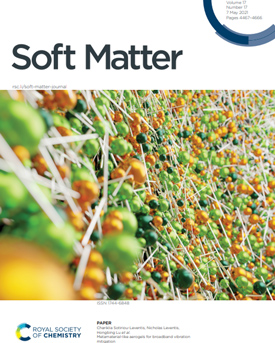
Mechanical Engineers Discover that Aerogel Structure Can Block Sound, Potentially Boost Performance of Acoustic Devices

A team at The University of Texas at Dallas has discovered that the internal shape of a material created from a type of gel can help block sound and boost performance of products such as earplugs and earphones without increasing the size or mass.
In the work featured on the cover and inside a May issue of the Royal Society of Chemistry journal Soft Matter, the team isolated four specific groups of polymer aerogels that have the same chemical composition and different morphological structures and tested vibration mitigation, or the ability to absorb sound waves. The aerogels comprised of microspheres and tiny hair-like fibers had the lowest vibration transmissibility.
“When this material is subject to a mechanical vibration load, the vibration energy is consumed internally by these suspended microspheres vibrating on nanofibrous springs,” said Dr. Hongbing Lu, Louis A. Beecherl Chair, professor of mechanical engineering in the Erik Jonsson School of Engineering and Computer Science, team leader and corresponding author of the work. “This is a unique mechanical energy absorption mechanism that has not yet been seen in any natural materials.”

aerogel structure that
provided superior vibration reduction.
Lu’s Mechanics of Advanced Materials Laboratory (MAML) studies experimental mechanics, nanomechanics and multifunctional polymer aerogels. Polymer aerogels are a fascinating class of low-density, nanoporous materials that combine the very desirable material properties, including flexibility, substantial sound attenuation and mechanical energy absorption. They are described as metamaterials, which are engineered materials that have properties not found in naturally occurring materials, that are created by replacing liquids with gases in a polymer gel in a drying process. Aerogels as a class of materials are used in a wide variety of products, from the insulation of offshore oil pipelines to NASA space equipment.
In prior work, Lu has studied their superior properties in mitigating broadband noise and wanted to determine which morphological structures would block the greatest frequency range of acoustic waves. In addition to the aerogels with the “hair”, the other structures of the aerogels studied were caterpillar-like assemblies of nanoparticles, random assemblies of nanoparticles and entangled nanofibers.
The group was able to isolate a specific morphology or shape of aerogel that can block a greater range of frequencies, so products such as earplugs, earphones and larger acoustic panels may include the specific metastructure of aerogel that will most greatly improve performance without changing the chemical composition.

Sadeq Malakooti PhD’20, Mohammad Hatamleh PhD’19 and Rui Zhang PhD’20, all former research assistants in mechanical engineering at UT Dallas, participated in this work. Researchers from the Missouri University of Science and Technology and Rensselaer Polytechnic Institute also contributed.
The research is funded in part by the National Science Foundation, Sandia National Laboratories and the Army Research Office.







